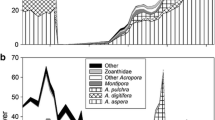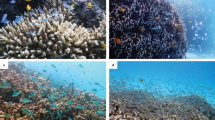Abstract
We evaluated the role that demography may play in the formation of local aggregations of Sinularia flexibilis (Quoy & Gaimard, 1833), a soft coral that commonly dominates inshore coral reefs of the Great Barrier Reef (GBR), Australia. Two populations on inshore reefs of the Palm Islands were censused once a year for 3 years, starting 10 mo after the extensive bleaching mortality in early 1998. Larger colonies became more prevalent over time; mean colony size increasing by 35%, from 276 cm2 in 1998 to 373 cm2 in 2000. Growth rates were size dependent, with smaller colonies growing proportionally faster than larger colonies. Change in size relative to initial size indicated an expected mean annual growth of 128 cm2 for a 50-cm2 colony. Zero growth was predicted at 532±21cm2, with colonies larger than this likely to undergo fission or shrink. Forty-three percent of colonies were undergoing fission at any time at both localities. Most new colonies were produced by fission (70%, n=285), with the remainder produced by the recruitment of sexually produced larvae (19%) or by colony translocation (11%). The sexual and asexual recruitment rates were 0.24 and 1.0 recruits m- 2 year−1, respectively. Opportunistic recruitment and rapid growth following disturbances are commonly assumed to be the mechanisms leading soft corals to dominate locally. In this study, these mechanisms operated more slowly than expected, with no net change in population size.
Similar content being viewed by others
References
C. Bastidas (2002) Population Dynamics and Genetic Structure of Species with Local Dominance on Coral Reefs: a Case Study of the Soft Corals Sinularia flexibilis and Clavularia koellikeri.Ph.D. Thesis James Cook University Townsville
C. Bastidas J. A. H. Benzie S. Uthicke K. E. Fabricius (2001) ArticleTitleGenetic differentiation among populations of a broadcast spawning soft coral, Sinularia flexibilis, on the Great Barrier Reef Marine Biology 138 517–525 Occurrence Handle10.1007/s002270000480 Occurrence Handle1:CAS:528:DC%2BD3MXivFGmtbs%3D
D. Z. Ben-Yosef Y. Benayahu (1999) ArticleTitleThe gorgonian coral Acabaria biserialis: life history of a successful colonizer of artificial substrata Marine Biology 135 473–481
Y. Benayahu D. Weil M. Kleinman (1990) Radiation of broadcasting and brooding patterns in coral reef alcyonaceans M. Hoshi O. Yamashita (Eds) Advances in Invertebrate Reproduction, Vol.5. Elsevier Science Publishers London
Y. Benayahu Y. Loya (1984) ArticleTitleLife history studies on the Red Sea soft coral Xenia macrospiculata Gohar,1940. II. Planulae shedding and post larval development Biological Bulletin 166 44–53
Y. Benayahu Y. Loya (1986) ArticleTitleSexual reproduction of a soft coral: synchronous and brief annual spawning of Sarcophyton glaucum Biological Bulletin 170 32–42
Y. Benayahu Y. Loya (1987) ArticleTitleLong-term recruitment of soft-corals (Octocorallia: Alcyonacea) on artificial substrata at Eilat (Red Sea) Marine Ecology Progress Series 38 161–167
R. Berkelmans (2001) Bleaching, Upper Thermal Limits and Temperature Adaptation in Reef Corals Ph.D. Thesis Dissertation James Cook University Townsville
D. A. Brazeau H. R. Lasker (1992) ArticleTitleGrowth rates and growth strategy in a clonal marine invertebrate, the Caribbean octocoral Briareum asbestinum Biological Bulletin 183 269–277
A. H. Cheetham L. C. Hayek E. Thomsen (1980) ArticleTitleBranching structure in arborescent animals: models of relative growth Journal of Theoretical Biology 85 335–369 Occurrence Handle10.1016/0022-5193(80)90025-9 Occurrence Handle7431960 Occurrence Handle1:STN:280:Bi6D2M%2FnvF0%3D
E. E. Cordes J. W. Nybakken G. VanDykhuizen (2001) ArticleTitleReproduction and growth of Anthomastus ritteri (Octocorallia: Alcyonacea) from Monterey Bay, California, USA Marine Biology 138 491–501 Occurrence Handle10.1007/s002270000470
M. Dahan Y. Benayahu (1997) ArticleTitleClonal propagation by the azooxanthellate octocoral Dendronephtya hemprichi Coral Reefs 16 5–12 Occurrence Handle10.1007/s003380050053
Z. D. Dinesen (1985) ArticleTitleAspects of life history of a stolon-bearing species of Efflatounaria (Octocorallia: Xeniidae) Proceedings of the Fifth International Coral Reef Congress 6 89–94
T. A. Ebert (1999) Plant and Animal Populations. Methods in Demography Academic Press San Diego
K. E. Fabricius (1995) ArticleTitleSlow population turnover in the soft coral genera Sinularia and Sarcophyton on mid- and outer-shelf reefs of the Great Barrier Reef Marine Ecology Progress Series 126 145–152
K. E. Fabricius (1997) ArticleTitleSoft coral abundance in the central Great Barrier Reef: effects of Acanthaster planci, space availability and aspects of the physical environment Coral Reefs 16 159–167 Occurrence Handle10.1007/s003380050070
K. E. Fabricius M. Dommisse (2000) ArticleTitleDepletion of suspended particulate matter over coastal reef communities dominated by zooxanthellate soft corals Marine Ecology Progress Series 196 157–167 Occurrence Handle1:CAS:528:DC%2BD3cXosFKhs7o%3D
R. I. C. C. Francis (1995) ArticleTitleAn alternative mark-recapture analogue of Schnute’s growth model Fisheries Research 23 95–111 Occurrence Handle10.1016/0165-7836(94)00336-U
J. Garrabou (1999) ArticleTitleLife-history traits of Alcyonium acaule and Parazoanthus axinellae (Cnidaria, Anthozoa), with emphasis on growth Marine Ecology Progress Series 178 193–204
N. J. Gotelli (1988) ArticleTitleDeterminants of recruitment, juvenile growth, and spatial distribution of a shallow-water gorgonian Ecology 69 157–166
R. W. Grigg (1974) ArticleTitleGrowth rings: annual periodicity in two gorgonian corals Ecology 55 876–881
R. W. Grigg (1977) ArticleTitlePopulation dynamics of two gorgonian corals Ecology 58 278–290
P. L. Harrison C. C. Wallace (1990) Reproduction, dispersal and recruitment of scleractinian corals Z. Dubinsky (Eds) Ecosystems of the World Elsevier Science Publishers Amsterdam 133–207
R. N. Hughes J. M. Cancino (1985) An ecological overview of cloning methazoa J. B. C. Jackson L. W. Buss R.E. Cook (Eds) Population Biology and Evolution of Clonal Organisms Yale University Press New Haven and London 153–186
T. P. Hughes (1984) ArticleTitlePopulation dynamics based on individual size rather than age: a general model with a reef coral example American Naturalist 123 778–795 Occurrence Handle10.1086/284239
T. P. Hughes J. B. C. Jackson (1980) ArticleTitleDo corals lie about their age?Some demographic consequences of partial mortality, fission and fusion Science 209 713–715
T. P. Hughes J. B. C. Jackson (1985) ArticleTitlePopulation dynamics and life histories of foliaceous corals Ecological Monographs 55 141–166
J. B. C. Jackson (1985) Distribution and ecology of clonal and aclonal benthic invertebrates J. B. C. Jackson L. W. Buss R.E. Cook (Eds) Population Biology and Evolution of Clonal Organisms Yale University Press New Haven and London
R. H. Karlson T. P. Hughes S. R. Karlson (1996) ArticleTitleDensity-dependent dynamics of soft coral aggregations: the significance of clonal growth and form Ecology 77 1592–1599
H. R. Lasker (1988) ArticleTitleThe incidence and rate of vegetative propagation among coral reef alcyonaceans Proceedings of the Sixth International Coral Reef Symposium 2 763–768
H. R. Lasker (1990) ArticleTitleClonal propagation and population dynamics of a gorgonian coral Ecology 71 1578–1589
P. A. Marshall A. H. Baird (2000) ArticleTitleBleaching of corals on the Great Barrier Reef: differential susceptibilities among taxa Coral Reefs 19 155–163 Occurrence Handle10.1007/s003380000086
C. S. McFadden (1991) ArticleTitleA comparative demographic analysis of clonal reproduction in a temperate soft coral Ecology 72 1849–1866
K. P. Sebens (1983) ArticleTitleSettlement and metamorphosis of a temperate soft coral larvae (Alcyonium siderium Verril): induction by crustose algae Biological Bulletin 165 286–304
J. E. Tanner (2001) ArticleTitleThe influence of clonality on demography: patterns in expected longevity and survivorship Ecology 82 1971–1981
G. C. Williams (1975) Sex and Evolution Princeton University Press Princeton, New Jersey
A. E. Woods R. C. Ellis (1994) Laboratory Histopathology. A Complete Reference Churchill Livingstone Edinburgh
Author information
Authors and Affiliations
Corresponding author
Rights and permissions
About this article
Cite this article
Bastidas, C., Fabricius, K.E. & Willis, B.L. Demographic aspects of the soft coral Sinularia flexibilis leading to local dominance on coral reefs. Hydrobiologia 530, 433–441 (2004). https://doi.org/10.1007/s10750-004-2663-7
Issue Date:
DOI: https://doi.org/10.1007/s10750-004-2663-7




